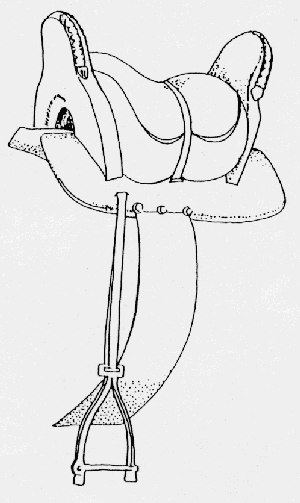Revisiting Stirrups
Today, stirrups revisited. The University of Houston's College of Engineering presents this series about the machines that make our civilization run, and the people whose ingenuity created them.
By now, anyone who's studied medieval history has encountered Lynn White's argument that an energetic western culture began with the stirrup. In 1962, White's book, Medieval Technology and Social Change, told how the Frankish king, Charles Martel, recognized the military potential of stirruped horsemen in 742 AD. After that, horse breeding greatly increased. The horse was integrated into agriculture, and the seeds of a new power technology were sown.
Another book also came out in 1962: The Structure of Scientific Revolutions by Thomas Kuhn. Kuhn described how science develops, not by accretion, but by replacement — by paradigm replacement. After Kuhn, paradigm found a new place in our language.
I realize how cautious I need to be about using superlatives; but I really believe that these have been the two most significant works of history since WW-II. They redirected historical thinking.
Of course they also became lightning rods for criticism. The game of trying to topple these two giants has been unabated for forty years. In 1997, for example, Rice University devoted a semester-long public seminar series to deconstructing Kuhn.
Both books were audacious. Both made fearless generalizations. Both clearly were flawed in many ways. Both have been dented by their critics. And both remain standing. They remind me of yet another book: Darwin's On the Origin of Species.
I'm astonished by people who try to refute natural selection by going back to Darwin himself. Never mind that we've spent a century and a half weaving the connecting tissue of evolution by natural selection. You'd think Darwin had written the last word on the subject, not the first.
Perhaps the villain in all this is our need to pin everything on one creator genius — Einstein, Edison, Bell. That erases all the labor needed to complete any really good idea. Thomas Kuhn is far from the only reason we've put aside our old ideas about standing on the shoulders of giants to build science, brick upon brick. As Kuhn's detractors have gone at him, and stripped him of his original hyperbole, they've left him much stronger.
Now historian Alex Roland goes back to look at White's book. He treats White's critics with patience and with a solid understanding. They've filled in blanks and corrected errors. By subjecting a grand generalization to a vigorous shaking, Rowland says, they've reasserted its importance.
Kuhn, White, and Darwin are fine reminders that nothing is finished in its first incarnation. Did the Wright Brothers get it wrong because they put the tail in front? Was Edison wrong to record on a wax cylinder instead of a CD? I suppose if we need to be absolutely right, we'll shy away from any of our important progenitors. But, if we want to see creative change in full flower, we have to go to the delicious flawed beginnings.
I'm John Lienhard, at the University of Houston, where we're interested in the way inventive minds work.
(Theme music)
A. Roland, Once more into the Stirrups. Technology and Culture, Vol. 44, No. 3, July 2003, pp. 574-585.
White, L., Jr., Medieval Technology and Social Change. New York: Oxford University Press, 1966. (first published in 1962.)
Kuhn, T. S., The Structure of Scientific Revolutions. Chicago: The University of Chicago Press, 1970. (first published in 1962.)
C. Darwin, On the Origin of Species. New York: Modern Library, 1990. (first published in 1859.) You may read this on line at: http://www.literature.org/authors/darwin-charles/the-origin-of-species/

A medieval war saddle with stirrups.